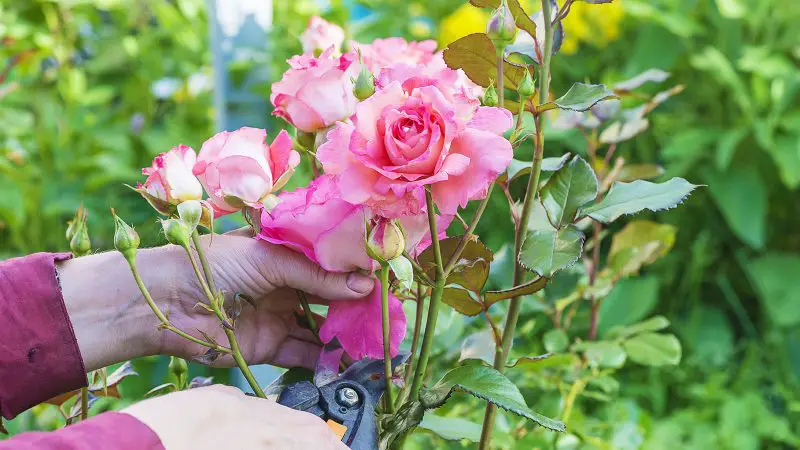Climbing roses add elegance and color to any garden with their cascading blooms and vibrant fragrance. Proper pruning is essential to maintain their shape, encourage strong growth, and maximize flower production. Many gardeners struggle to prune effectively, leading to sparse blooms or weak stems.
This guide provides detailed, step-by-step advice on how to prune climbing roses correctly. It covers tools, timing, pruning techniques, and common mistakes. By following these tips, gardeners can ensure healthier plants, more abundant flowers, and a visually stunning garden all season long.
Understanding Climbing Roses

Climbing roses are unique among rose varieties due to their long, flexible canes that require support for optimal growth. Unlike bush roses, climbers grow vertically along trellises, fences, or pergolas, creating dramatic vertical displays. Their growth habit allows them to cover large areas and provide stunning seasonal color. Understanding their biology and growth patterns is crucial for effective pruning and maintenance.
These roses are classified into two main types: once-blooming and repeat-blooming. Once-blooming climbers produce a single flush of flowers in late spring or early summer, often on old wood. Repeat-blooming varieties flower multiple times throughout the season, primarily on new growth. Knowing the type of climber you have informs pruning timing and technique. Pruning too early or too late can reduce flowering or damage healthy stems.
Climbing roses also differ in growth vigor and hardiness. Some varieties are vigorous, requiring regular training and pruning to prevent sprawling. Others are more compact and manageable but still benefit from structured pruning. Climate, soil, and sunlight impact growth, flowering, and disease resistance. By understanding climbing rose types, growth habits, and environmental needs, gardeners can implement pruning strategies that promote strong stems, abundant blooms, and overall plant health. Proper knowledge ensures a thriving, visually appealing rose display year after year.
Choosing the Right Tools for Pruning
Using proper tools is essential for effective pruning of climbing roses. Sharp, clean tools create precise cuts, minimizing damage to stems and reducing the risk of disease. Bypass pruners are ideal for smaller stems, while loppers or pruning saws handle thicker canes. Maintaining tool quality ensures smooth cuts and promotes faster healing for the plant.
Safety and comfort are also important when selecting pruning tools. Ergonomic handles reduce hand strain during long pruning sessions, while gloves protect from thorns and scratches. For taller climbers, consider long-handled pruners or pole saws to reach high branches without climbing. Clean tools between cuts, especially if plants show signs of disease, to prevent spreading pathogens from one stem to another.
Proper preparation of tools and understanding their functions improve pruning efficiency and plant health. Using the right tool for each stem ensures cuts are clean and positioned correctly, encouraging vigorous growth and abundant blooms. Well-chosen, maintained tools allow gardeners to prune climbing roses effectively, safely, and confidently, resulting in healthier plants with stunning, well-structured blooms throughout the growing season.
Timing Your Pruning for Optimal Blooms
Pruning climbing roses at the right time is critical for maximizing blooms and maintaining healthy growth. The timing depends on the type of climber you have. Once-blooming roses should be pruned immediately after flowering, typically in late spring or early summer, to avoid cutting off next year’s flower buds. Repeat-blooming varieties benefit from light pruning in early spring and selective cuts throughout the growing season to encourage new growth and continuous flowering.
Environmental conditions also affect pruning timing. Avoid heavy pruning during frost periods or extreme heat. Spring pruning should coincide with the plant beginning to show new growth but before buds swell fully. Winter pruning is often reserved for removing dead or damaged wood, while summer pruning focuses on shaping and maintaining airflow. Observing local climate patterns helps gardeners determine the best moment for pruning to prevent stress and maximize flower production.
Correct timing ensures that energy is directed toward producing strong canes and vibrant blooms rather than excessive vegetative growth. Understanding the growth cycle, flower bud formation, and seasonal patterns allows gardeners to plan pruning schedules effectively. By aligning pruning with natural growth, climbers remain vigorous, well-structured, and visually striking. Timely pruning not only enhances flowering but also improves plant health, reducing susceptibility to diseases and encouraging longevity in the garden. Well-timed cuts result in climbing roses that are abundant, resilient, and beautiful year after year.
Step-by-Step Pruning Techniques for Climbing Roses
Preparing Your Climbing Roses
Before beginning any pruning, it is essential to thoroughly inspect your climbing roses. Remove any dead, damaged, or diseased canes to prevent the spread of infections. Examine each stem carefully, cutting back to healthy tissue. Clean, precise cuts using sharp pruners or loppers promote rapid healing and reduce stress on the plant. Removing unhealthy stems early encourages vigorous growth and maintains the plant’s structural integrity.
Next, prepare the surrounding area to make pruning safer and more efficient. Clear away weeds, fallen leaves, or debris that might obstruct your work. Organize all necessary tools, including gloves, pruning shears, loppers, and saws, within easy reach. A well-prepared environment reduces physical strain and minimizes accidental damage to stems. Proper preparation ensures that each pruning session is efficient, safe, and beneficial for long-term plant health.
Additionally, consider observing the plant’s overall growth pattern before cutting. Identify strong, healthy canes that should remain to support flowers and structure. Understanding which canes are productive versus non-productive allows for strategic removal that enhances future blooms. With careful preparation, climbing roses are set up for successful pruning, stronger growth, and abundant flowering.
Shaping and Training Canes
Once the plant is ready, focus on shaping and training its canes. Select long, flexible stems suitable for tying to trellises, arches, or other supports. Remove overcrowded stems to improve airflow and sunlight penetration. Proper spacing not only prevents fungal diseases but also encourages even growth and more abundant blooms along each cane.
Use soft garden ties, twine, or strips of fabric to secure canes loosely to supports. Avoid tight binding that can constrict growth and damage stems. Train canes horizontally or vertically depending on the desired design. Horizontal training encourages more lateral flowering, while vertical growth creates height and visual impact. Strategically shaping and directing growth ensures the plant is balanced, aesthetically pleasing, and structurally strong.
Regular observation during the growing season allows you to adjust training as necessary. New shoots can be guided to maintain the intended shape, and excessive growth can be lightly pruned to prevent overcrowding. By managing cane placement carefully, gardeners can maximize flower production and maintain healthy, resilient climbing roses.
Encouraging New Growth and Blooms
After shaping and training, the next step is to actively promote new growth and ensure abundant flowering on your climbing roses. Focus on identifying weak, thin, or non-productive shoots and trim them carefully. Removing these less vigorous stems allows the plant to redirect energy into stronger canes, which will support more flowers and maintain structural balance. Always leave healthy buds intact, as they will develop into the next season’s blooms. Regular observation helps determine which shoots contribute to long-term productivity versus those that drain resources.
Deadheading spent blooms is an essential practice to stimulate continuous flowering. By cutting back faded flowers just above a healthy leaf node, the plant is encouraged to produce new shoots and buds instead of directing energy into seed formation. This simple yet consistent maintenance keeps climbing roses vibrant and full of life throughout the growing season. Combining deadheading with light selective pruning improves airflow within the plant, reducing the risk of fungal diseases and promoting overall plant health.
In addition to pruning and deadheading, consider nutritional and environmental support to enhance growth and flowering. Apply a balanced fertilizer during active growth periods to supply essential nutrients, and ensure consistent watering to maintain soil moisture without waterlogging. Mulching helps retain moisture and regulate soil temperature, while monitoring for pests and disease prevents stress that can hinder bloom development. By integrating careful pruning, deadheading, and attentive seasonal care, climbing roses will remain structurally sound, resilient, and capable of producing a stunning, long-lasting display of flowers year after year.
Common Mistakes to Avoid When Pruning Climbing Roses
Cutting Too Much at Once
A common error is removing too much growth in a single session. Over-pruning stresses the plant, limits flower production, and can expose stems to disease. Many gardeners mistakenly think that cutting back aggressively will stimulate blooms, but it often delays flowering or weakens canes. Removing too many healthy shoots reduces energy reserves needed for new growth.
To avoid this, prune gradually and focus on removing only dead, damaged, or overcrowded stems. Leave enough strong canes to support continuous flowering while maintaining proper airflow. Incremental pruning allows the plant to recover quickly and prevents shock. Observing how your climbing roses respond each season helps refine pruning techniques. Over time, careful, measured cuts lead to healthier, more resilient plants that produce abundant, vibrant blooms year after year.
Pruning at the Wrong Time
Timing errors are another frequent issue. Pruning too early in winter or too late after buds develop can dramatically reduce flowering. Once-blooming varieties are especially vulnerable; cutting old wood too late may remove all next season’s flower buds. Repeat-blooming types need carefully timed maintenance to encourage continuous flowering.
Gardeners should monitor the plant’s growth cycle and local climate conditions. Spring pruning is ideal when new shoots appear but before buds swell fully. Summer pruning focuses on deadheading and shaping, while minimal fall pruning prevents winter damage. Correct timing enhances stem strength, encourages abundant blooms, and reduces susceptibility to disease. Understanding seasonal growth patterns ensures climbing roses reach full flowering potential without compromising plant health.
Ignoring Plant Structure
Neglecting the natural structure leads to tangled, overcrowded canes that limit flowering and airflow. Crossed or rubbing stems increase disease risk and reduce bloom quality. Properly training long, flexible canes along trellises, fences, or arches is essential for aesthetic appeal and plant health.
Focus on horizontal or vertical arrangement based on garden design. Remove weak or inward-growing shoots to open the canopy for light and air. Maintaining a balanced structure prevents overcrowding and promotes stronger flowering stems. Consistently guiding the growth ensures climbing roses remain vigorous, visually attractive, and floriferous while reducing the likelihood of pests, disease, and structural stress. Proper architecture supports long-term plant health and maximum bloom production.
Troubleshooting Pruning Challenges
Pruning climbing roses can present challenges even for experienced gardeners. One common issue is poor bloom production after pruning. This often occurs when cuts remove too many flower buds or when pruning is done at the wrong time. Another factor is weak or spindly growth, which may result from over-pruning or insufficient sunlight. Addressing these problems requires careful observation and adjustment of pruning techniques.
To encourage stronger growth and abundant blooms, always identify the type of climber and its flowering pattern. Once-blooming varieties should be pruned immediately after flowering, while repeat-blooming types benefit from light spring pruning and selective cuts during the season. Ensuring adequate sunlight, water, and nutrients supports healthy cane development. If blooms are sparse, check for overcrowded stems that may be shading each other or restricting airflow, and remove them to open the canopy.
Another challenge is dealing with disease or pest damage. Fungal infections and insects can weaken stems, making pruning more difficult and potentially spreading disease. Sterilize pruning tools between cuts, remove infected wood promptly, and monitor plant health regularly. By addressing timing, structural issues, and disease prevention, gardeners can overcome common pruning challenges. Proper troubleshooting ensures climbing roses remain vigorous, well-shaped, and capable of producing stunning, abundant flowers season after season.
Seasonal Care Tips for Pruned Climbing Roses
Spring Care for Pruned Roses
After spring pruning, climbing roses require proper care to recover and produce abundant blooms. Begin by watering deeply to encourage root growth and provide nutrients for developing canes. Applying a balanced, slow-release fertilizer supports new shoots and prepares the plant for its flowering season. Mulching around the base retains moisture, moderates soil temperature, and suppresses weeds.
Regular monitoring for pests and disease is essential in spring. Remove any yellowing or damaged leaves promptly and inspect for aphids or fungal infections. Training new growth along trellises or supports ensures that canes are properly positioned for optimal sunlight exposure. Consistent care during this critical period strengthens the plant, promotes vigorous growth, and sets the stage for healthy, vibrant flowers throughout the season.
Summer Care for Continuous Bloom
During summer, climbing roses require consistent watering, especially in hot and dry conditions. Deep watering at the base helps maintain soil moisture without wetting foliage excessively, reducing fungal risks. Deadhead spent flowers to stimulate further blooms and prevent energy waste on fading flowers. Light pruning may also help manage excessive growth and maintain the desired shape.
Nutrient management continues to be important. Applying a high-phosphorus fertilizer encourages flower production while maintaining strong stems. Monitor for signs of stress such as wilting or discoloration, and adjust watering or shading as needed. Summer care ensures that pruned climbing roses maintain vigor and produce a continuous display of blooms while resisting environmental stressors.
Fall Care for Preparing Winter
In fall, focus shifts to protecting climbing roses for the winter months. Reduce watering as temperatures drop to prevent root rot, but ensure the soil does not dry out completely. Remove fallen leaves and debris to minimize fungal risks. Apply a layer of mulch or compost around the base for insulation and nutrient retention.
Inspect canes for weak or damaged stems and prune lightly if necessary, focusing on maintaining structure. Avoid heavy pruning, which can stimulate tender new growth susceptible to frost damage. Preparing plants carefully in fall ensures they survive winter and emerge strong and healthy in the following spring.
Winter Protection and Maintenance
Winter care is essential for maintaining climbing rose health after pruning. Protect roots and canes by adding mulch or straw around the base, and consider wrapping delicate stems with burlap in colder regions. Shelter young or vulnerable plants from harsh winds to prevent cane breakage.
Avoid heavy pruning during winter, as this can expose the plant to frost damage. Instead, use the time to plan spring pruning and inspect supports for stability. Proper winter protection preserves the structural integrity of climbing roses, ensures survival through cold months, and promotes vigorous growth and abundant flowering in the next season.
Harvesting and Propagation Tips for Climbing Roses
Propagating Climbing Roses
Propagation of climbing roses is an excellent way to multiply favorite varieties or share them with fellow gardeners. Semi-hardwood cuttings taken in late summer, when stems are firm but still flexible, provide the highest success rates. Select canes that are healthy, vigorous, and free of disease or damage. Cut sections approximately six to eight inches long, removing leaves from the lower half to reduce water loss and encourage root development.
Using rooting hormone on the cut ends stimulates faster root formation and increases the likelihood of success. Plant cuttings in a well-draining mix, such as sand combined with peat moss, and maintain consistent moisture without waterlogging. Place cuttings in a bright, warm location with indirect sunlight, and consider covering them with a plastic dome or bag to preserve humidity. Regularly check for signs of rot or fungal infection. With proper care, cuttings can establish strong roots in several weeks, allowing gardeners to cultivate new climbing roses successfully and expand their gardens sustainably.
Harvesting Blooms for Arrangements
Pruned climbing roses can also provide beautiful, long-lasting blooms for indoor arrangements, adding fragrance and visual appeal to any space. Harvest flowers early in the morning when the stems are fully hydrated. Use clean, sharp shears to make diagonal cuts above a healthy leaf node, minimizing stress on the plant and avoiding damage to surrounding canes. Frequent harvesting encourages new blooms and promotes continued flowering throughout the season.
After cutting, place stems immediately in water to maintain freshness. Remove any diseased or damaged leaves to prevent contamination. Regularly monitor the parent plant for pests or fungal infections that could affect harvested blooms. Strategic harvesting not only enhances indoor floral displays but also directs the plant’s energy toward producing strong new shoots. By combining careful propagation and thoughtful bloom harvesting, gardeners can maintain climbing roses that are healthy, floriferous, and visually stunning year after year.
Common Diseases and Pest Management for Climbing Roses
Fungal Diseases
Fungal infections are a frequent issue for climbing roses, especially in regions with high humidity or poor air circulation. Black spot, powdery mildew, and rust are the most common fungal problems. Black spot manifests as round, black lesions on leaves, causing yellowing and premature leaf drop, weakening the plant. Powdery mildew appears as white, powdery patches on stems, buds, and leaves, inhibiting photosynthesis. Rust shows as bright orange pustules on the undersides of leaves, leading to defoliation and reduced flowering.
Preventing fungal infections begins with proper plant care. Space roses adequately and prune regularly to improve airflow, reducing moisture accumulation. Water at the base rather than overhead to keep foliage dry. Apply fungicides only when necessary, following manufacturer instructions, and always remove and dispose of infected leaves. Using disease-resistant varieties, maintaining healthy soil, and ensuring sufficient sunlight are key strategies. Consistent monitoring and early intervention keep climbing roses healthy, strong, and capable of producing vibrant, abundant blooms throughout the growing season.
Insect Pests
Climbing roses attract a range of insect pests, including aphids, spider mites, and Japanese beetles. Aphids cluster on tender new growth, sucking sap and causing curling or distorted leaves. Spider mites are tiny but destructive, forming webs on leaves and causing stippled, yellowed foliage. Japanese beetles feed aggressively on flowers and leaves, sometimes defoliating entire canes if uncontrolled. Other pests, such as thrips and rose slugs, can also damage buds and foliage.
Effective pest management relies on early detection and consistent care. Inspect plants regularly, especially new shoots and blooms. For small infestations, use insecticidal soap or neem oil to reduce populations safely. Handpick larger pests like beetles, and prune heavily infested stems when necessary. Encouraging beneficial insects, such as ladybugs and lacewings, helps control pest numbers naturally. Proper watering, fertilization, and pruning strengthen the plant’s resilience, making it less attractive to pests while promoting abundant flowering and long-term health.
Preventive Care and Maintenance
Preventive care is the cornerstone of maintaining healthy climbing roses and minimizing disease and pest issues. Regular pruning removes weak or dead wood, improving air circulation and reducing infection risk. Cleaning and sterilizing tools between cuts prevents disease spread. Removing fallen leaves, debris, and spent flowers limits fungal spores and insect habitats. Mulching maintains consistent soil moisture, regulates temperature, and suppresses weeds, supporting overall plant health.
Consistent observation is essential. Monitor for subtle signs of stress, discoloration, unusual growth, or insect activity. Adjust watering schedules to avoid water stress or waterlogged soil, and provide balanced fertilization to encourage strong, disease-resistant canes. By combining proactive maintenance with timely treatment interventions, gardeners can enjoy thriving climbing roses that produce abundant, vibrant blooms season after season, ensuring longevity, structural strength, and overall garden beauty.
FAQ About How to Prune Climbing Roses for More Blooms
What is the best time to prune climbing roses?
The best time depends on the type of climber. Once-blooming varieties should be pruned immediately after flowering in late spring or early summer. Repeat-blooming roses benefit from light spring pruning and selective cuts during the growing season to encourage continuous blooms and strong, healthy growth.
How much should I prune my climbing roses?
Avoid removing too much growth at once. Focus on cutting dead, damaged, or overcrowded stems while preserving healthy canes. Over-pruning weakens the plant, reduces flowering, and exposes stems to disease. Gradual pruning ensures strong growth, abundant blooms, and maintains the plant’s structural integrity throughout the season.
What tools are necessary for pruning climbing roses?
Sharp, clean bypass pruners are ideal for small stems, while loppers or saws handle thicker canes. Gloves protect hands from thorns, and long-handled tools help reach high branches. Sterilize tools between cuts to prevent disease spread. Proper tools ensure clean cuts and promote healthy, vigorous growth.
How do I propagate climbing roses successfully?
Take semi-hardwood cuttings in late summer. Select healthy, disease-free stems, remove lower leaves, and dip cut ends in rooting hormone. Plant in a well-draining medium, maintain humidity, and place in indirect sunlight. Regular monitoring for rot or disease ensures successful rooting and vigorous new plants.
How can I prevent pests and diseases on climbing roses?
Regular pruning, proper spacing, and good airflow reduce fungal risk. Inspect plants frequently for aphids, spider mites, or beetles. Remove infected leaves, use insecticidal soap, and encourage beneficial insects. Maintaining healthy soil, balanced fertilization, and consistent watering strengthens plants, minimizing susceptibility to pests and diseases.
Conclusion
Pruning climbing roses correctly is essential for healthy growth, abundant blooms, and long-term plant vitality. Understanding rose types, timing, and proper techniques prevents common mistakes and promotes vigorous canes. Combining careful pruning with seasonal care, pest management, and propagation strategies ensures your climbing roses thrive year after year. With patience and attention to detail, gardeners can enjoy visually stunning, well-structured roses that transform any garden into a vibrant, fragrant paradise, creating lasting beauty and rewarding seasonal displays.






